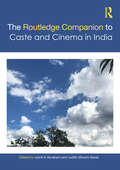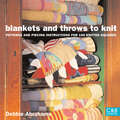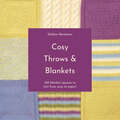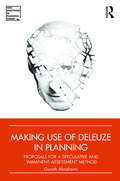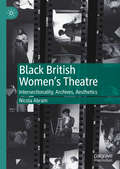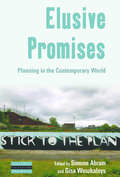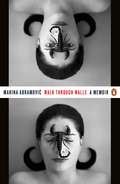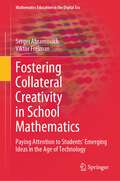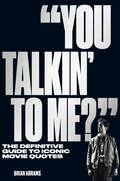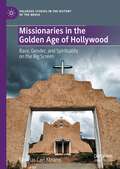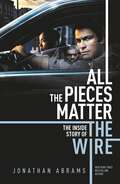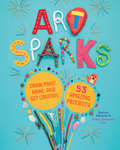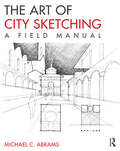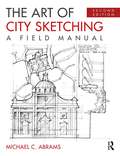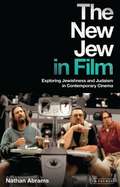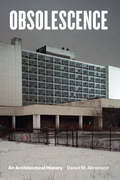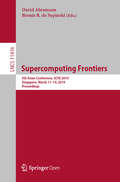- Table View
- List View
The Routledge Companion to Caste and Cinema in India
by Joshil K. Abraham Judith Misrahi-BarakThis companion is the first study of caste and its representation in Indian cinema. It unravels the multiple layers of caste that feature directly and indirectly in Indian movies, to examine not only the many ways caste pervades Indian society and culture but also how the struggle against it adopts multiple strategies. The companion: • critiques Indian cinema production through the lens of anti-caste discourse; • traces the history of films beginning from the early twentieth century, focusing on caste representations across India, including Hindi, Malayalam, Kannada, Marathi, Bengali, Punjabi, Tamil as well as silent films; • makes a foray into OTT media; • includes analysis of popular films such as Padmaavat, Masaan, Fandry, Sairat, Sujata, Article 15, Chomana Dudi, Lagaan, Court, Ee.Ma.Yau, Kaala, Pariyerum Perumal, Perariyathavar, among many others, to critique and problematise the idea of caste. A major intervention, this book alters traditional approaches to ‘caste’ in Indian cinemas and society and explores new political strategies implemented through cinematic creation and aesthetics. It will be indispensable for scholars and researchers of film studies, social discrimination and exclusion studies, human rights, popular culture, and South Asian studies. It will also be of interest to enthusiasts of Indian cinematic history.
Blankets and Throws To Knit: Patterns And Piecing Instructions For 100 Knitted Squares
by Debbie AbrahamsOver 100 different blanket squares can be knitted up to create a dozen unique afghans in a variety of styles. Projects range from baby's first comfort blanket in subdued pastels, to brightly coloured motifs embellished with beads and buttons for the spirited teenager.
Cosy Throws and Blankets: 100 Blanket Squares To Knit From Easy To Expert
by Debbie AbrahamsOriginally a follow-up to the outstandingly successful Blankets and Throws, the newly reformatted Cosy Throws & Blankets (previously published as More Blankets and Throws) has over 100 different blanket squares that can be knitted up to create a dozen unique blankets or throws in a variety of styles.
Making Use of Deleuze in Planning: Proposals for a speculative and immanent assessment method (New Directions in Planning Theory)
by Gareth AbrahamsMaking Use of Deleuze in Planning translates and re-creates some of Gilles Deleuze’s most abstract philosophical concepts to form a new, practicable planning assessment tool. It shows what his philosophy can do for planning theory as well as planning assessment practice and, in doing so, sets out a pragmatic approach to Deleuzian studies: one that helps form bridges between ontological problems and the problems found in professional practice. It also breaks new ground in assessment methodology by challenging the essentialist ideas underpinning assessment methods like BREEAM and setting out and testing a new form of non-essentialist assessment named SIAM. The book argues that Deleuze’s philosophy can be made useful to planning as long as one is prepared to adapt and re-create his key ontological concepts to respond to the specific demands of the field.
Making Use of Deleuze in Planning: Proposals for a speculative and immanent assessment method (New Directions in Planning Theory)
by Gareth AbrahamsMaking Use of Deleuze in Planning translates and re-creates some of Gilles Deleuze’s most abstract philosophical concepts to form a new, practicable planning assessment tool. It shows what his philosophy can do for planning theory as well as planning assessment practice and, in doing so, sets out a pragmatic approach to Deleuzian studies: one that helps form bridges between ontological problems and the problems found in professional practice. It also breaks new ground in assessment methodology by challenging the essentialist ideas underpinning assessment methods like BREEAM and setting out and testing a new form of non-essentialist assessment named SIAM. The book argues that Deleuze’s philosophy can be made useful to planning as long as one is prepared to adapt and re-create his key ontological concepts to respond to the specific demands of the field.
Black British Women's Theatre: Intersectionality, Archives, Aesthetics
by Nicola AbramThis book marks a significant methodological shift in studies of black British women’s theatre: it looks beyond published plays to the wealth of material held in archives of various kinds, from national repositories and themed collections to individuals’ personal papers. It finds there a cache of unpublished manuscripts and production recordings distinctive for their non-naturalistic aesthetics. Close analysis of selected works identifies this as an intersectional feminist creative practice. Chapters focus on five theatre companies and artists, spanning several decades: Theatre of Black Women (1982-1988), co-founded by Booker Prize-winning writer Bernardine Evaristo; Munirah Theatre Company (1983-1991); Black Mime Theatre Women’s Troop (1990-1992); Zindika; and SuAndi. The book concludes by reflecting on the politics of representation, with reference to popular postmillennial playwright debbie tucker green. Drawing on new interviews with the playwrights/practitioners and their peers, this book assembles a rich, interconnected, and occasionally corrective history of black British women’s creativity. By reproducing 22 facsimile images of flyers, production programmes, photographs and other ephemera, Black British Women’s Theatre: Intersectionality, Archives, Aesthetics not only articulates a hidden history but allows its readers their own encounter with the fragile record of this vibrant past.
Elusive Promises: Planning in the Contemporary World (Dislocations #11)
by Simone Abram Gisa WeszkalnysPlanning in contemporary democratic states is often understood as a range of activities, from housing to urban design, regional development to economic planning. This volume sees planning differently—as the negotiation of possibilities that time offers space. It explores what kind of promise planning offers, how such a promise is made, and what happens to it through time. The authors, all leading anthropologists, examine the time and space, creativity and agency, authority and responsibility, and conflicting desires that plans attempt to control. They show how the many people involved with planning deal with the discrepancies between what is promised and what is done. The comparative essays offer insight into the expected and unexpected outcomes of planning (from visionary utopias to bureaucratic dystopia or something in-between), how the future is envisioned at the outset, and what actual work is done and how it affects people’s lives.
Walk Through Walls: A Memoir
by Marina Abramovic'Her bravest work of performance art to date . . . Rawly intimate' ObserverThis memoir spans Marina Abramovic's five decade career, and tells a life story that is almost as exhilarating and extraordinary as her groundbreaking performance art. Taking us from her early life in communist ex-Yugoslavia, to her time as a young art student in Belgrade in the 1970s, where she first made her mark with a series of pieces that used the body as a canvas, the book also describes her relationship with the West German performance artist named Ulay who was her lover and sole collaborator for 12 years.
Fostering Collateral Creativity in School Mathematics: Paying Attention to Students’ Emerging Ideas in the Age of Technology (Mathematics Education in the Digital Era #23)
by Sergei Abramovich Viktor FreimanThis book explores the topic of using technology, both physical and digital, to motivate creative mathematical thinking among students who are not considered ‘mathematically advanced.’ The book reflects the authors’ experience of teaching mathematics to Canadian and American teacher candidates and supervising several field-based activities by the candidates. It consists of eight chapters and an Appendix which includes details of constructing computational learning environments.Specifically, the book demonstrates how the appropriate use of technology in the teaching of mathematics can create conditions for the emergence of what may be called ‘collateral creativity,’ a notion similar to Dewey’s notion of collateral learning. Just as collateral learning does not result from the immediate goal of the traditional curriculum, collateral creativity does not result from the immediate goal of traditional problem solving. Rather, mathematical creativity emerges as a collateral outcome of thinking afforded by the use of technology. Furthermore, collateral creativity is an educative outcome of one’s learning experience with pedagogy that motivates students to ask questions about computer-generated or tactile-derived information and assists them in finding answers to their own or the teacher’s questions. This book intends to provide guidance to teachers for fostering collateral creativity in their classrooms.
"You Talkin' to Me?": The Definitive Guide to Iconic Movie Quotes
by Brian AbramsThis deep dive into hundreds of Hollywood&’s most iconic and beloved lines is a must-have for every film buff."You Talkin&’ to Me?" is a fun, fascinating, and exhaustively reported look at all the iconic Hollywood movie quotes we know and love, from Casablanca to Dirty Harry and The Godfather to Mean Girls. Drawing on interviews, archival sleuthing, and behind-the-scenes details, the book examines the origins and deeper meanings of hundreds of film lines: how they&’ve impacted, shaped, and reverberated through the culture, defined eras in Hollywood, and become cemented in the modern lexicon. Packed with film stills, sidebars, lists, and other fun detours throughout movie history, the book covers all genres and a diverse range of directors, writers, and audiences.
Missionaries in the Golden Age of Hollywood: Race, Gender, and Spirituality on the Big Screen (Palgrave Studies in the History of the Media)
by Douglas Carl AbramsThis book examines major British and American missionary films during the Golden Age of Hollywood to explore the significance of race, gender, and spirituality in relation to the lives of the missionaries portrayed in film during the middle third of the twentieth century. Film both influences and reflects culture, and racial, gender, and religious identities are some of the most debated issues globally today. In the movies explored in this book, missionary interactions with various people groups reflect the historical changes which took place during this time.
All the Pieces Matter: The Inside Story of The Wire
by Jonathan AbramsThe definitive oral history of the iconic and beloved TV show The Wire, as told by the actors, writers, directors, and others involved in its creationSince its final episode aired in 2008, the acclaimed crime drama The Wire has only become more popular and influential. The issues it tackled, from the failures of the drug war and criminal justice system to systemic bias in law enforcement and other social institutions, have become more urgent and central to the national conversation. The show's actors, such as Idris Elba and Dominic West, have gone on to become major stars. Its creators and writers, including David Simon and Richard Price, have developed dedicated cult followings of their own. Universities use the show to teach everything from film theory, to criminal justice and sociology. Politicians and activists reference it when discussing policy. When critics compile lists of the Greatest TV Shows of All Time, The Wire routinely takes the top spot. It is arguably one of the great works of art America has produced in the 21st century.But while there has been a great deal of critical analysis of the show and its themes, until now there has never been a definitive, behind-the-scenes take on how it came to be made. With unparalleled access to all the key actors and writers involved in its creation, Jonathan Abrams tells the astonishing, compelling, and complete account of The Wire, from its inception and creation through its end and powerful legacy.'From the moment The Wire ended, all I have wished for is one more season. Jonathan Abrams has given us something just as valuable — the complete story of how something this wonderful, rich, and intricate came to be' - Mike Schur, creator of Parks and Recreation, Brooklyn 99 and The Good Place'The definitive dissection of television’s most politically meaningful invention' - Chuck Klosterman, New York Times bestselling author of But What if We’re Wrong? and I Wear The Black Hat'Abrams indisputably has created a thorough examination of The Wire’s conception, production, and lingering cultural afterlife' - Publishers Weekly
Art Sparks: Draw, Paint, Make, and Get Creative with 53 Amazing Projects!
by Marion Abrams Hilary Emerson LayThis lively, colorful compendium of arts and crafts for a new generation of kids features projects specially designed to spark creativity, invite self-expression, and nurture self-confidence. From finger puppets to fabric flags to shrink art, each activity uses inexpensive materials and can be crafted in less than 90 minutes.
The Art of City Sketching: A Field Manual
by Michael AbramsThe Art of City Sketching: A Field Manual guides you through the laborious and sometimes complex process of sketching what you see in the built environment so that you can learn to draw what you imagine. Illustrated with hundreds of drawings by students and professionals of cityscapes around Europe and the United States, the book helps you develop your conceptual drawing skills so that you can communicate graphically to represent the built environment. Short exercises, projects, drawing tips, step-by-step demonstrations, and composition do's and don'ts make it easy for you to get out into the city and experiment in your own work. Author Michael Abrams uses his experience as a field sketching instructor, to show you that by drawing, you can discover, analyze, and comprehend the built environment.
The Art of City Sketching: A Field Manual
by Michael AbramsThe Art of City Sketching: A Field Manual guides you through the laborious and sometimes complex process of sketching what you see in the built environment so that you can learn to draw what you imagine. Illustrated with hundreds of drawings by students and professionals of cityscapes around Europe and the United States, the book helps you develop your conceptual drawing skills so that you can communicate graphically to represent the built environment. Short exercises, projects, drawing tips, step-by-step demonstrations, and composition do's and don'ts make it easy for you to get out into the city and experiment in your own work. Author Michael Abrams uses his experience as a field sketching instructor, to show you that by drawing, you can discover, analyze, and comprehend the built environment.
The Art of City Sketching: A Field Manual
by Michael C. AbramsThe Art of City Sketching: A Field Manual guides readers through the process of freehand architectural sketching and explains orthographic, diagrammatic, three-dimensional, and perceptual-type drawings. The book presents hundreds of drawings of historic buildings and urban spaces, examples, and exercises, which help readers develop their drawing skills and employ sketching as an analytical tool. The book is divided into three parts, based on the reader’s skill level: beginner, intermediate, and advanced. As an architect and field sketching instructor, the author shows that through drawing the reader can discover, analyze, and comprehend the built environment. The new edition of The Art of City Sketching expands on the drawing techniques of the previous version by adding new drawing examples, exercises, and two new chapters—Chiaroscuro and Storyboard. New drawing tips, demonstrations, and composition "do’s and don’ts" will support readers when they illustrate their viewpoint of the city by using simple drawing tools. The lessons in this book will allow readers to mix method with imagination and sensibility.
The Art of City Sketching: A Field Manual
by Michael C. AbramsThe Art of City Sketching: A Field Manual guides readers through the process of freehand architectural sketching and explains orthographic, diagrammatic, three-dimensional, and perceptual-type drawings. The book presents hundreds of drawings of historic buildings and urban spaces, examples, and exercises, which help readers develop their drawing skills and employ sketching as an analytical tool. The book is divided into three parts, based on the reader’s skill level: beginner, intermediate, and advanced. As an architect and field sketching instructor, the author shows that through drawing the reader can discover, analyze, and comprehend the built environment. The new edition of The Art of City Sketching expands on the drawing techniques of the previous version by adding new drawing examples, exercises, and two new chapters—Chiaroscuro and Storyboard. New drawing tips, demonstrations, and composition "do’s and don’ts" will support readers when they illustrate their viewpoint of the city by using simple drawing tools. The lessons in this book will allow readers to mix method with imagination and sensibility.
The New Jew in Film: Exploring Jewishness and Judaism in Contemporary Cinema
by Nathan AbramsJewish film characters have existed almost as long as the medium itself. But around 1990, films about Jews and their representation in cinema proliferated and took on new forms, marking a significant departure from the past. With a new generation of Jewish filmmakers, writers, actresses and actors at work, contemporary cinemas in Hollywood and the rest of the world have been depicting a multiplicity of new Jews, including tough Jews, brutish Jews, gay and lesbian Jews, Jewish cowboys, skinheads and superheroes, and Jews in space.The New Jew in Film is grounded in the study of over 300 films in Hollywood and beyond, including productions from Argentina, Australia, Canada, Germany, Hungary, Italy, Mexico, Russia, Spain, Sweden and the United Kingdom, as well as the United States and Israel. It explores these newand changing depictions of Jews, Jewishness and Judaism, providing a wider, more representative picture of the subject than has hitherto been attempted. This is a compelling, surprising and provocative book, whose chapters explore masculinity, femininity, sexuality, passivity, agency, religion, as well as new territory, including foodand bathrooms. Nathan Abrams's concern is to reveal how the representation of the Jew is used to convey confidence or anxieties about Jewish identity and history, as well as how it engages with questions of racial, sexual and gender politics. Inso doing, he also provides a welcome overview of important Jewish films produced globally over the last twenty years.
Obsolescence: An Architectural History
by Daniel M. AbramsonIn our architectural pursuits, we often seem to be in search of something newer, grander, or more efficient—and this phenomenon is not novel. In the spring of 1910 hundreds of workers labored day and night to demolish the Gillender Building in New York, once the loftiest office tower in the world, in order to make way for a taller skyscraper. The New York Times puzzled over those who would sacrifice the thirteen-year-old structure, “as ruthlessly as though it were some ancient shack.” In New York alone, the Gillender joined the original Grand Central Terminal, the Plaza Hotel, the Western Union Building, and the Tower Building on the list of just one generation’s razed metropolitan monuments. In the innovative and wide-ranging Obsolescence, Daniel M. Abramson investigates this notion of architectural expendability and the logic by which buildings lose their value and utility. The idea that the new necessarily outperforms and makes superfluous the old, Abramson argues, helps people come to terms with modernity and capitalism’s fast-paced change. Obsolescence, then, gives an unsettling experience purpose and meaning. Belief in obsolescence, as Abramson shows, also profoundly affects architectural design. In the 1960s, many architects worldwide accepted the inevitability of obsolescence, experimenting with flexible, modular designs, from open-plan schools, offices, labs, and museums to vast megastructural frames and indeterminate building complexes. Some architects went so far as to embrace obsolescence’s liberating promise to cast aside convention and habit, envisioning expendable short-life buildings that embodied human choice and freedom. Others, we learn, were horrified by the implications of this ephemerality and waste, and their resistance eventually set the stage for our turn to sustainability—the conservation rather than disposal of resources. Abramson’s fascinating tour of our idea of obsolescence culminates in an assessment of recent manifestations of sustainability, from adaptive reuse and historic preservation to postmodernism and green design, which all struggle to comprehend and manage the changes that challenge us on all sides.
Obsolescence: An Architectural History
by Daniel M. AbramsonIn our architectural pursuits, we often seem to be in search of something newer, grander, or more efficient—and this phenomenon is not novel. In the spring of 1910 hundreds of workers labored day and night to demolish the Gillender Building in New York, once the loftiest office tower in the world, in order to make way for a taller skyscraper. The New York Times puzzled over those who would sacrifice the thirteen-year-old structure, “as ruthlessly as though it were some ancient shack.” In New York alone, the Gillender joined the original Grand Central Terminal, the Plaza Hotel, the Western Union Building, and the Tower Building on the list of just one generation’s razed metropolitan monuments. In the innovative and wide-ranging Obsolescence, Daniel M. Abramson investigates this notion of architectural expendability and the logic by which buildings lose their value and utility. The idea that the new necessarily outperforms and makes superfluous the old, Abramson argues, helps people come to terms with modernity and capitalism’s fast-paced change. Obsolescence, then, gives an unsettling experience purpose and meaning. Belief in obsolescence, as Abramson shows, also profoundly affects architectural design. In the 1960s, many architects worldwide accepted the inevitability of obsolescence, experimenting with flexible, modular designs, from open-plan schools, offices, labs, and museums to vast megastructural frames and indeterminate building complexes. Some architects went so far as to embrace obsolescence’s liberating promise to cast aside convention and habit, envisioning expendable short-life buildings that embodied human choice and freedom. Others, we learn, were horrified by the implications of this ephemerality and waste, and their resistance eventually set the stage for our turn to sustainability—the conservation rather than disposal of resources. Abramson’s fascinating tour of our idea of obsolescence culminates in an assessment of recent manifestations of sustainability, from adaptive reuse and historic preservation to postmodernism and green design, which all struggle to comprehend and manage the changes that challenge us on all sides.
Obsolescence: An Architectural History
by Daniel M. AbramsonIn our architectural pursuits, we often seem to be in search of something newer, grander, or more efficient—and this phenomenon is not novel. In the spring of 1910 hundreds of workers labored day and night to demolish the Gillender Building in New York, once the loftiest office tower in the world, in order to make way for a taller skyscraper. The New York Times puzzled over those who would sacrifice the thirteen-year-old structure, “as ruthlessly as though it were some ancient shack.” In New York alone, the Gillender joined the original Grand Central Terminal, the Plaza Hotel, the Western Union Building, and the Tower Building on the list of just one generation’s razed metropolitan monuments. In the innovative and wide-ranging Obsolescence, Daniel M. Abramson investigates this notion of architectural expendability and the logic by which buildings lose their value and utility. The idea that the new necessarily outperforms and makes superfluous the old, Abramson argues, helps people come to terms with modernity and capitalism’s fast-paced change. Obsolescence, then, gives an unsettling experience purpose and meaning. Belief in obsolescence, as Abramson shows, also profoundly affects architectural design. In the 1960s, many architects worldwide accepted the inevitability of obsolescence, experimenting with flexible, modular designs, from open-plan schools, offices, labs, and museums to vast megastructural frames and indeterminate building complexes. Some architects went so far as to embrace obsolescence’s liberating promise to cast aside convention and habit, envisioning expendable short-life buildings that embodied human choice and freedom. Others, we learn, were horrified by the implications of this ephemerality and waste, and their resistance eventually set the stage for our turn to sustainability—the conservation rather than disposal of resources. Abramson’s fascinating tour of our idea of obsolescence culminates in an assessment of recent manifestations of sustainability, from adaptive reuse and historic preservation to postmodernism and green design, which all struggle to comprehend and manage the changes that challenge us on all sides.
Obsolescence: An Architectural History
by Daniel M. AbramsonIn our architectural pursuits, we often seem to be in search of something newer, grander, or more efficient—and this phenomenon is not novel. In the spring of 1910 hundreds of workers labored day and night to demolish the Gillender Building in New York, once the loftiest office tower in the world, in order to make way for a taller skyscraper. The New York Times puzzled over those who would sacrifice the thirteen-year-old structure, “as ruthlessly as though it were some ancient shack.” In New York alone, the Gillender joined the original Grand Central Terminal, the Plaza Hotel, the Western Union Building, and the Tower Building on the list of just one generation’s razed metropolitan monuments. In the innovative and wide-ranging Obsolescence, Daniel M. Abramson investigates this notion of architectural expendability and the logic by which buildings lose their value and utility. The idea that the new necessarily outperforms and makes superfluous the old, Abramson argues, helps people come to terms with modernity and capitalism’s fast-paced change. Obsolescence, then, gives an unsettling experience purpose and meaning. Belief in obsolescence, as Abramson shows, also profoundly affects architectural design. In the 1960s, many architects worldwide accepted the inevitability of obsolescence, experimenting with flexible, modular designs, from open-plan schools, offices, labs, and museums to vast megastructural frames and indeterminate building complexes. Some architects went so far as to embrace obsolescence’s liberating promise to cast aside convention and habit, envisioning expendable short-life buildings that embodied human choice and freedom. Others, we learn, were horrified by the implications of this ephemerality and waste, and their resistance eventually set the stage for our turn to sustainability—the conservation rather than disposal of resources. Abramson’s fascinating tour of our idea of obsolescence culminates in an assessment of recent manifestations of sustainability, from adaptive reuse and historic preservation to postmodernism and green design, which all struggle to comprehend and manage the changes that challenge us on all sides.
Obsolescence: An Architectural History
by Daniel M. AbramsonIn our architectural pursuits, we often seem to be in search of something newer, grander, or more efficient—and this phenomenon is not novel. In the spring of 1910 hundreds of workers labored day and night to demolish the Gillender Building in New York, once the loftiest office tower in the world, in order to make way for a taller skyscraper. The New York Times puzzled over those who would sacrifice the thirteen-year-old structure, “as ruthlessly as though it were some ancient shack.” In New York alone, the Gillender joined the original Grand Central Terminal, the Plaza Hotel, the Western Union Building, and the Tower Building on the list of just one generation’s razed metropolitan monuments. In the innovative and wide-ranging Obsolescence, Daniel M. Abramson investigates this notion of architectural expendability and the logic by which buildings lose their value and utility. The idea that the new necessarily outperforms and makes superfluous the old, Abramson argues, helps people come to terms with modernity and capitalism’s fast-paced change. Obsolescence, then, gives an unsettling experience purpose and meaning. Belief in obsolescence, as Abramson shows, also profoundly affects architectural design. In the 1960s, many architects worldwide accepted the inevitability of obsolescence, experimenting with flexible, modular designs, from open-plan schools, offices, labs, and museums to vast megastructural frames and indeterminate building complexes. Some architects went so far as to embrace obsolescence’s liberating promise to cast aside convention and habit, envisioning expendable short-life buildings that embodied human choice and freedom. Others, we learn, were horrified by the implications of this ephemerality and waste, and their resistance eventually set the stage for our turn to sustainability—the conservation rather than disposal of resources. Abramson’s fascinating tour of our idea of obsolescence culminates in an assessment of recent manifestations of sustainability, from adaptive reuse and historic preservation to postmodernism and green design, which all struggle to comprehend and manage the changes that challenge us on all sides.
Obsolescence: An Architectural History
by Daniel M. AbramsonIn our architectural pursuits, we often seem to be in search of something newer, grander, or more efficient—and this phenomenon is not novel. In the spring of 1910 hundreds of workers labored day and night to demolish the Gillender Building in New York, once the loftiest office tower in the world, in order to make way for a taller skyscraper. The New York Times puzzled over those who would sacrifice the thirteen-year-old structure, “as ruthlessly as though it were some ancient shack.” In New York alone, the Gillender joined the original Grand Central Terminal, the Plaza Hotel, the Western Union Building, and the Tower Building on the list of just one generation’s razed metropolitan monuments. In the innovative and wide-ranging Obsolescence, Daniel M. Abramson investigates this notion of architectural expendability and the logic by which buildings lose their value and utility. The idea that the new necessarily outperforms and makes superfluous the old, Abramson argues, helps people come to terms with modernity and capitalism’s fast-paced change. Obsolescence, then, gives an unsettling experience purpose and meaning. Belief in obsolescence, as Abramson shows, also profoundly affects architectural design. In the 1960s, many architects worldwide accepted the inevitability of obsolescence, experimenting with flexible, modular designs, from open-plan schools, offices, labs, and museums to vast megastructural frames and indeterminate building complexes. Some architects went so far as to embrace obsolescence’s liberating promise to cast aside convention and habit, envisioning expendable short-life buildings that embodied human choice and freedom. Others, we learn, were horrified by the implications of this ephemerality and waste, and their resistance eventually set the stage for our turn to sustainability—the conservation rather than disposal of resources. Abramson’s fascinating tour of our idea of obsolescence culminates in an assessment of recent manifestations of sustainability, from adaptive reuse and historic preservation to postmodernism and green design, which all struggle to comprehend and manage the changes that challenge us on all sides.
Supercomputing Frontiers: 5th Asian Conference, SCFA 2019, Singapore, March 11–14, 2019, Proceedings (Lecture Notes in Computer Science #11416)
by David Abramson Bronis R. de SupinskiThis open access book constitutes the refereed proceedings of the 5th Asian Supercomputing Conference, SCFA 2019, held in Singapore in March 2019. The 6 full papers presented in this book were carefully reviewed and selected from 33 submissions. They cover a range of topics including memory fault handling, linear algebra, image processing, heterogeneous computing, resource usage prediction, and data caching.
